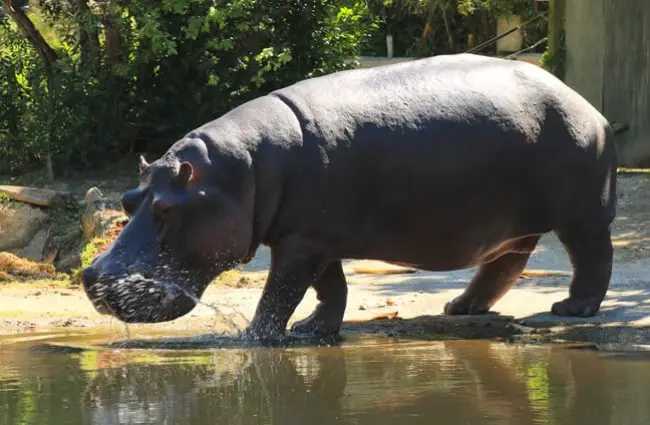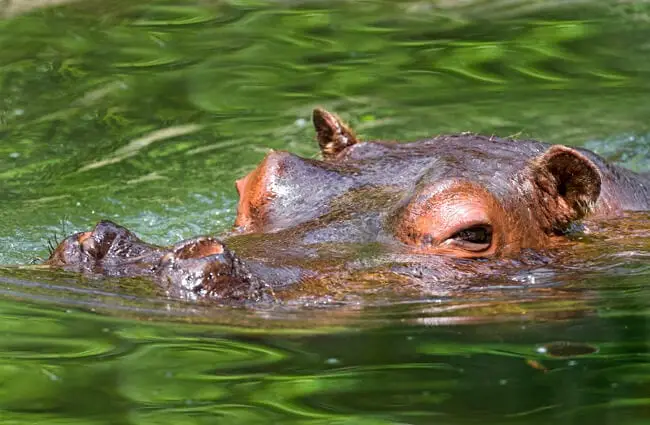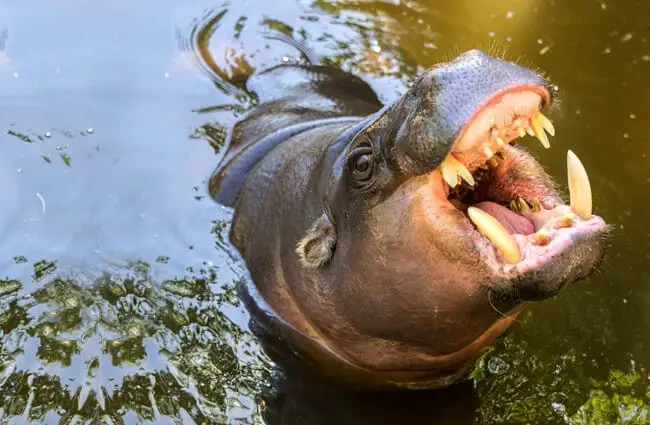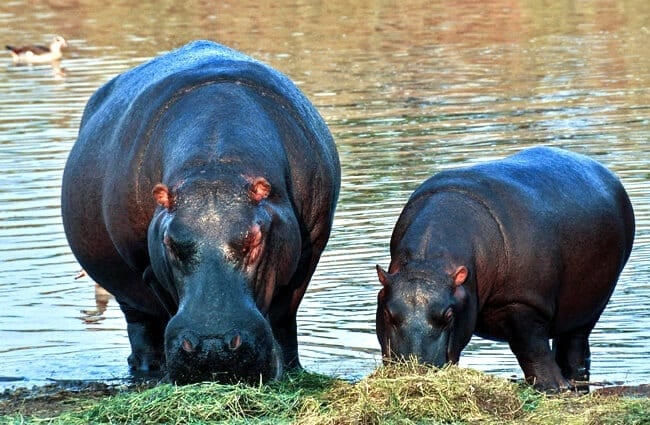Deep within the heart of Africa’s waterways lurks a creature of immense power and surprising grace: the hippopotamus. Often misunderstood, these colossal mammals are far more than just large, aquatic grazers. They are architects of their ecosystems, ancient survivors with a fascinating evolutionary tale, and a vital part of the continent’s natural and cultural tapestry. Join us on a journey to uncover the secrets of the hippopotamus, from their daily routines to their profound impact on the world around them.

The Water Horse: An Introduction to Hippos
The name “hippopotamus” itself, derived from ancient Greek, means “river horse,” a fitting moniker for an animal that spends the vast majority of its life submerged. While they may resemble oversized pigs at first glance, their true lineage is far more surprising. There are two main species of hippopotamus:
- The Common Hippopotamus (Hippopotamus amphibius): The iconic giant of African rivers, lakes, and swamps.
- The Pygmy Hippopotamus (Choeropsis liberiensis): A much smaller, shyer, and more solitary forest dweller found in the swamps and forests of West Africa.
This article will primarily focus on the Common Hippopotamus, the more widely recognized and studied of the two, while acknowledging the unique characteristics of its smaller cousin.
Where Do Hippos Call Home?
Common Hippopotamuses are endemic to sub-Saharan Africa, thriving in regions with abundant permanent water sources. Their range stretches across many countries, from East Africa’s Great Rift Valley lakes to the rivers of West Africa. These magnificent creatures require deep enough water to fully submerge themselves, along with accessible grassy banks for nocturnal grazing. Ideal habitats include:
- Large rivers with slow-moving currents.
- Expansive freshwater lakes.
- Swamps and marshlands.
For the aspiring wildlife enthusiast hoping to spot a hippopotamus in its natural environment, the best opportunities often arise during safaris in countries like Kenya, Tanzania, Uganda, Zambia, and Botswana. Look for them during the day in large pods, partially submerged in rivers or lakes, often with only their eyes, ears, and nostrils visible above the waterline. Dusk and dawn are prime times to observe them emerging from the water to graze on land.

What’s on the Hippo Menu?
Despite their formidable size and fearsome tusks, hippos are strict herbivores, primarily grazers. Their diet consists almost exclusively of short grasses found on riverbanks and floodplains. They are not predators, nor do they typically eat aquatic vegetation. A single adult hippopotamus can consume an astonishing 40 to 50 kilograms (about 88 to 110 pounds) of grass in a single night’s grazing session. They use their wide, muscular lips to pluck and tear grass, rather than using their teeth for chewing in the same way as other herbivores.
A Day in the Life of a Hippo: Behavior and Routine
Hippos lead a largely nocturnal existence when it comes to feeding. They spend their days submerged in water, often in large social groups known as “pods” or “schools,” which can number from 10 to 30 individuals, and sometimes up to 100. This aquatic lifestyle serves several crucial purposes:
- Temperature Regulation: Their thick skin is surprisingly sensitive to the sun and prone to drying out and cracking. Water provides essential cooling and protection.
- Skin Protection: Submersion prevents sunburn and keeps their skin hydrated.
- Buoyancy: The water supports their massive weight, making movement easier and conserving energy.
As dusk falls, hippos emerge from the water to graze on land, sometimes traveling several kilometers inland in search of prime pastures. They are highly territorial in the water, with dominant males fiercely defending their stretches of river or lake against rivals. On land, however, their territorial instincts are less pronounced, and they tend to be more tolerant of each other while feeding.
Physical Marvels: Adaptations of a Semi-Aquatic Giant
The hippopotamus is a masterclass in evolutionary adaptation for a semi-aquatic lifestyle. Here are some of their most remarkable physical traits:
- Strategic Placement of Sensory Organs: Their eyes, ears, and nostrils are located on the top of their heads, allowing them to remain almost entirely submerged while still being able to see, hear, and breathe.
- Webbed Feet: While not fully webbed like a duck’s, their feet have connective tissue between the toes, aiding in propulsion and stability in muddy riverbeds.
- “Blood Sweat”: Hippos secrete a reddish, oily fluid from glands in their skin. This unique substance, often mistaken for blood, acts as a natural sunscreen, moisturizer, and antiseptic, protecting their sensitive skin from the sun’s harsh rays and preventing infections.
- Massive Jaws and Tusks: Their mouths can open incredibly wide, up to 150 degrees. While their molars are designed for grinding grass, their enormous canine teeth, or tusks, are primarily for fighting and defense, not for eating. These tusks can grow up to 50 centimeters (20 inches) long in males.
- Impressive Lung Capacity: Hippos can hold their breath for an impressive 5 to 6 minutes, allowing them to spend significant time underwater.
- Surprising Speed on Land: Despite their bulky appearance, hippos can run at speeds of up to 30 kilometers per hour (19 mph) over short distances on land, making them surprisingly agile when threatened.
- Thick Skin: Their skin can be up to 6 centimeters (2.4 inches) thick, providing excellent protection against injuries from rivals and predators.

Deeper Dives into the World of Hippos
An Ancient Lineage: The Evolutionary Journey of Hippos
For a long time, scientists believed hippos were closely related to pigs. However, modern genetic and fossil evidence has revealed a much more astonishing truth: the closest living relatives of hippopotamuses are cetaceans, the group that includes whales and dolphins! This shared ancestry points to a common semi-aquatic ancestor that lived approximately 50 to 60 million years ago. Both groups belong to the order Artiodactyla (even-toed ungulates), but their evolutionary paths diverged significantly, with hippos retaining their terrestrial grazing habits while cetaceans fully adapted to marine life. This evolutionary link highlights the incredible diversity and adaptability of life on Earth.
The Circle of Life: Mating and Reproduction
Hippopotamus reproduction is a fascinating process, often taking place entirely within the water. Females typically reach sexual maturity between 7 and 15 years of age, while males mature around the same time. The gestation period lasts approximately 8 months. A single calf is usually born, weighing between 25 and 50 kilograms (55 to 110 pounds).
- Underwater Birth: Most hippopotamus births occur underwater, a unique adaptation that allows the newborn calf to immediately begin its aquatic life.
- Instant Swimmers: Hippo calves are born with the ability to swim and surface for air almost immediately after birth.
- Underwater Nursing: Mothers nurse their young underwater, a remarkable feat that showcases the calf’s early aquatic prowess.
- Protective Mothers: Female hippos are fiercely protective of their young, often keeping them close and aggressively defending them from perceived threats, including other hippos and predators. Calves often ride on their mother’s backs in deeper water to stay safe.

Ecosystem Engineers: Hippos and Their World
Hippos are far more than just inhabitants of their environment; they are active shapers of it, playing a crucial role as “ecosystem engineers.”
- Channel Creation: Their constant movement through shallow waters creates and deepens channels, which can alter water flow and provide pathways for other aquatic species.
- Nutrient Cycling: By grazing on land at night and returning to the water to defecate during the day, hippos act as vital transporters of nutrients. Their waste enriches the aquatic ecosystem, providing food for algae, insects, and fish, thereby supporting the entire food web.
- Habitat Modification: Their grazing habits can influence the composition of riparian vegetation, creating open areas that benefit other grazers.
While generally peaceful with other species, hippos can be aggressive if provoked or if their young are threatened. Crocodiles occasionally prey on young hippos, but adult hippos are formidable opponents and generally left alone by most predators due to their size and aggression.

Giants and Humans: A Complex Relationship
The interaction between hippos and humans is a complex tapestry woven with awe, fear, and conflict.
- Cultural Significance: In many African cultures, hippos hold significant symbolic meaning. Ancient Egyptians revered the hippopotamus goddess Taweret, associated with fertility and childbirth, depicting her with the head of a hippopotamus.
- Human-Wildlife Conflict: Despite their herbivorous diet, hippos are widely considered one of Africa’s most dangerous animals. Their aggressive and territorial nature, especially when protecting calves or their path to water is blocked, can lead to fatal encounters with humans. As human populations expand and encroach on hippo habitats, conflicts over resources and space are increasing.
- Conservation Status: The Common Hippopotamus is classified as Vulnerable by the IUCN, primarily due to habitat loss, water scarcity, and poaching for their meat and ivory tusks. The Pygmy Hippopotamus is even more critically endangered, classified as Endangered, facing severe threats from deforestation and habitat fragmentation. Conservation efforts are crucial to ensure the survival of these magnificent animals.
Practical Insights for Hippo Encounters and Care
Encountering a Hippo in the Wild: Safety First
For hikers, photographers, or anyone venturing into hippo territory, understanding how to react to an encounter is paramount. Hippos are powerful and unpredictable, and caution is always advised.
- Maintain Distance: Always keep a significant distance, at least 100 meters (330 feet), from hippos, both in and out of the water.
- Never Block Their Path: Hippos have established paths to and from their grazing grounds and water sources. Never position yourself between a hippo and the water, as this is a primary trigger for aggression.
- Be Aware at Dusk and Dawn: These are the times hippos are most active on land. Exercise extreme caution near riverbanks and water bodies during these hours.
- Stay Alert: Listen for their distinctive grunts and snorts. Be aware of your surroundings, especially if walking through tall grass near water.
- If Charged: If a hippo charges, your best course of action is to seek immediate elevated ground, such as climbing a sturdy tree or finding a large rock. Running in a straight line on flat ground is often ineffective due to their surprising speed.
“Respect the hippo’s space. Their calm appearance in the water belies a powerful and territorial nature on land.”
Caring for Captive Hippos: A Zookeeper’s Guide
Caring for hippos in a zoological setting requires specialized knowledge and dedication to replicate their natural environment and meet their complex needs.
- Enclosure Design:
- Spacious Water Body: A large, deep pool is essential, allowing hippos to fully submerge, swim, and regulate their body temperature. Water quality must be meticulously maintained.
- Accessible Land Area: A substantial land area with soft substrate (like sand or grass) is needed for grazing, resting, and basking. Ramps or gentle slopes should provide easy access to and from the water.
- Temperature Control: In colder climates, water heaters are crucial to maintain appropriate water temperatures, especially during winter months, to prevent hypothermia and skin issues.
- Diet and Nutrition:
- High-Quality Forage: A primary diet of hay and fresh grass is essential, mimicking their natural grazing habits.
- Specialized Pellets: Supplementation with commercially prepared herbivore pellets ensures a balanced intake of vitamins and minerals.
- Controlled Feeding: Feeding should ideally occur in the evening to align with their nocturnal grazing patterns.
- Social Structure and Enrichment:
- Social Grouping: While males can be solitary, females and young often thrive in small social groups. Careful introductions and monitoring are necessary.
- Environmental Enrichment: Providing enrichment items like submerged toys, floating logs, or varied feeding locations encourages natural behaviors and prevents boredom.
- Substrate Manipulation: Allowing access to mud wallows or areas where they can dig can also provide enrichment.
- Health and Veterinary Care:
- Regular Health Checks: Routine veterinary examinations, including dental checks, are vital. Hippo tusks grow continuously and may require trimming in captivity.
- Skin Care: Monitoring for skin dryness, cracks, or infections is important, especially if they spend extended time out of water.
- Parasite Control: Regular deworming and parasite monitoring are standard practice.
- Safety Protocols:
- Strict Safety Measures: Due to their inherent aggression and power, strict safety protocols for zookeepers are paramount, including secure enclosures and controlled access during feeding and cleaning.
- Training: Positive reinforcement training can facilitate routine care and veterinary procedures, reducing stress for both animals and staff.
Beyond the Basics: More Intriguing Hippo Facts
- Long Lifespan: Hippos can live for 40 to 50 years in the wild, and even longer in captivity, with some individuals reaching over 60 years.
- Underwater Communication: Hippos communicate with a variety of grunts, roars, and bellows, some of which can travel both through the air and underwater.
- Dense Bones: Unlike many aquatic mammals, hippos do not have blubber. Instead, their bones are incredibly dense, helping them sink to the bottom of rivers and walk along the riverbed.
- Pygmy Hippo Differences: Pygmy hippos are much smaller (around 180-275 kg or 400-600 lbs), more solitary, have less pronounced webbed feet, and spend more time on land in dense forest undergrowth.
Conclusion: The Enduring Legacy of the River Horse
From their surprising evolutionary ties to whales to their critical role as ecosystem engineers, hippopotamuses are truly remarkable creatures. They are a testament to nature’s ingenuity, perfectly adapted to their semi-aquatic world. Understanding their biology, behavior, and the challenges they face is not just a pursuit for zoologists and researchers, but a call to action for all who appreciate the wild wonders of our planet. By respecting their space, supporting conservation efforts, and continuing to learn about these magnificent “river horses,” we can help ensure their powerful presence continues to grace the African waterways for generations to come.

![Red Angus Closeup of a beautiful Red Angus cowPhoto by: U.S. Department of Agriculture [pubic domain]https://creativecommons.org/licenses/by/2.0/](https://animals.net/wp-content/uploads/2020/03/Red-Angus-4-238x178.jpg)




![Red Angus Closeup of a beautiful Red Angus cowPhoto by: U.S. Department of Agriculture [pubic domain]https://creativecommons.org/licenses/by/2.0/](https://animals.net/wp-content/uploads/2020/03/Red-Angus-4-100x75.jpg)

